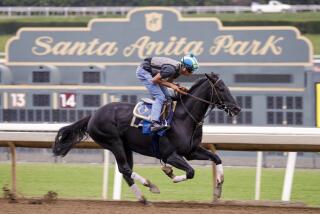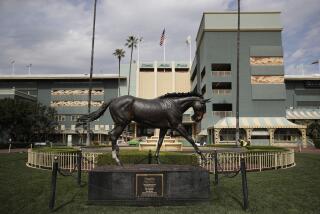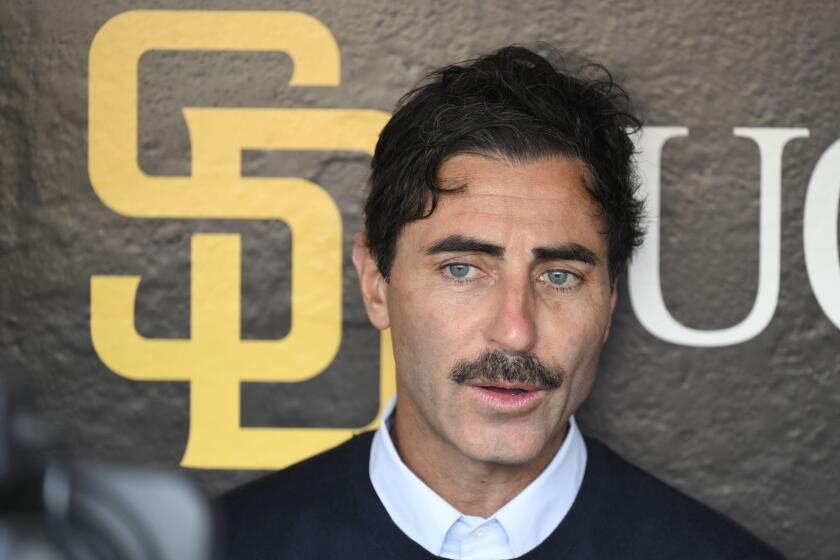Pressure is on Del Mar for things go right as Breeders’ Cup looms later in year

There is a digital clock in the foyer of the executive offices of the Del Mar Thoroughbred Club. Its bright red numbers are in constant movement.
Late Monday morning the clock read: 108 days, 12 hours, 23 minutes. And at that moment, 25 seconds.
That is the countdown to when Del Mar will host for the first time the biggest two days in horse racing, the Breeders’ Cup, on Nov. 3-4.
The clock is a reminder of the much-welcomed worldwide attention that will come for a racetrack that is still a mystery to some. Yet, Del Mar, in its 78th season, will be under more scrutiny than ever, beginning with the summer meeting that starts Wednesday.
“There’s definitely a different flavor in the air,” Del Mar President and Chief Executive Joe Harper said. “It smells a little more international.”
This year, Del Mar cut its racing schedule by three days with the hopes of giving its new superintendent more time to prepare the track while affording horses a longer rest following the close of Santa Anita’s meet July 4.
“We lose some money, but frankly, it was the right thing to do,” Harper said. “It gave us more time to get ready. It gave the horsemen more time on the track before the races start. We’re breathing a little easier.”
The breath holding will come on opening day and in the subsequent seven weeks as Del Mar tries to overcome the bad memories and negative publicity that came with 17 horse deaths in last year’s summer meeting and another five in the shorter fall season.
Protests from animal rights advocates grew more fervent as the summer season progressed and the deaths mounted, and Harper concluded at the end of the meet, “You look for a smoking gun, and sometimes there just isn’t one. The nature of the sport came to roost on our porch this summer.
“We’re going to be doing many things that we hope will cut down on these problems in the future.”
Beyond shortening the meet, Del Mar hired well-respected Santa Anita superintendent Dennis Moore to create a dirt racing surface that’s more consistent with Santa Anita’s; turns on the course were further banked to relieve stress on the horses’ legs; at least 200 fewer horses will be housed at Del Mar, reducing the number of overall workouts; and Harper said a system of greater scrutiny among veterinarians and track workers has been instituted in an effort to identify unhealthy horses before they’re entered in a race.
Any horse that hasn’t raced in more than a year will be carefully watched, Harper said.
On Monday, Hall of Fame trainer Bob Baffert said he had yet to breeze horses on the new Del Mar track, but had heard “good things” from jockeys after workouts began Saturday.
Baffert is a staunch defender of Del Mar and noted he trained the current No. 1 horse in the world, Arrogate, here all last summer and brought the winner of $17 million to race at Del Mar twice this summer before entering him in the Breeders’ Cup Classic.
“If I was worried about it, I wouldn’t be here with my horses,” Baffert said.
He added, “One thing that’s different here is the air. It’s heavy. The horses get tired, not so much because of the track but because of the air. A lot of horses will get tired the first time you work them, and that plays into it.”
Baffert said he was encouraged by the hiring of Moore, who he contends is among the best superintendents in the business.
Moore was not available for comment early in the week, but Harper said Moore has closely examined the track, digging down to the “sub-base” to look for even small inconsistencies.
It was Moore who also suggested the extra banking, bringing Del Mar to a 5-degree grade that is the same as Santa Anita’s. The additional work cost $250,000, Harper said.
Tom Robbins, who oversees racing at the track, has his own set of circumstances that have him feeling a little more nervous than usual heading into the meet. He has to fill eight to 10 races five days each week, and that became more concerning after Santa Anita had to cancel four days of racing this past meet for lack of entries.
Asked if he could envision that happening at Del Mar, Robbins said, “I would have said no until I saw it happen. It is unsettling. We’re doing our best to sort of calm everybody down, because it affects a lot of people who are employed in our industry.”
Harper said, “Our field sizes have been relatively good, even higher than Saratoga’s the last couple of years. We’re all feeling the drop in foal crops across the country. It started when everybody went broke in ’08 and all of a sudden there weren’t horses being bred for a couple of years, so you’re always kind of feeling that.”
More to Read
Go beyond the scoreboard
Get the latest on L.A.'s teams in the daily Sports Report newsletter.
You may occasionally receive promotional content from the Los Angeles Times.










